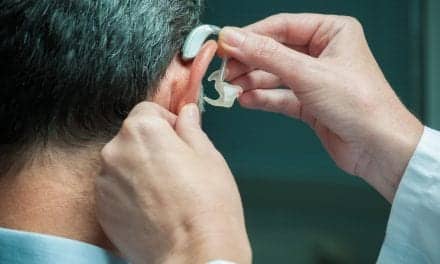The American Auditory Society (AAS), a non-partisan organization composed of all disciplines of hearing healthcare, held its second stand-alone scientific meeting in Scottsdale, AZ, during April. With its 200+ attendees coming from the professions of audiology, otolaryngology, hearing science, engineering and industry, the AAS Scientific Meeting offered a wide selection of topics ranging from newborn hearing screening to amplification and aural rehabilitation for older adults. This year’s event was composed of a half-day of manufacturer-presented technology updates followed by one-and-a-half days of seminars, featuring 54 short (15 min.) platform presentations, three special sessions, the Carhart Memorial Lecture and the AAS Luncheon. Additionally, a steak dinner was hosted on the final evening of the event at “Rawhide,” which featured covered wagons that were used in the filming of How the West Was Won.
Special Sessions
• AIED Research Findings: A panel of four researchers from the Mayo Clinic, Rochester, MN, provided details on Autoimmune Inner Ear Disease (AIED), which is a rapidly progressing, sensorineural form of hearing loss with an uncertain pathogenesis. Rheumatologist Eric Matteson, MD, says that AIED is usually characterized by rapid, progressive, assymetric hearing loss (often fluctuating and/or being associated with Meniere’s Disease), and it is often accompanied by vestibular symptoms of unsteadiness and ataxia. AIED strikes women more often than men, it can occur at any age (with middle-age people more commonly affected), and it is associated with autoimmune diseases in 29% of AIED patients. Matteson recommended a diagnostic battery for these patients that includes an audiogram, complete vestibular evaluation, MRT/CT, a general physical exam, as well as lab and serology tests for several diseases (e.g., syphilis and Lyme Disease). Evidence for this type of hearing loss being related to the immune system includes the fact that treatment with corticosteroids and immuno-suppressive therapies have led to improvements in hearing. Immunologist Scott Stromme, MD, explained that a non-specific reactant heat shock protein, called HSP 70, may be predictive of corticosteroid responsiveness. The panel discussed how, more recently, other less toxic therapies have been prescribed. In particular, methotrexate has been found to be a safer treatment option for autoimmune hearing loss and has improved the hearing of 12-of-17 patients in at least one ear at the Mayo Clinic.

Audiologist David Fabry, PhD, detailed several case studies of patients suffering from AIED with symptoms associated with Meniere’s Disease. Pure-tone and word scores are most helpful in assessment with any fluctuation of 10 dB or greater or an increase/decrease in word recognition scores, according to Fabry. Due to the fluctuating losses and drug treatments associated with AIED, he says these patients require hearing instruments that have volume controls, and the patients’ progress needs to be monitored closely by the audiologist and physician.
• Using Evidence-Based Medicine: “Sometimes we have forgotten how to be scholars,” says J. Gail Neely, MD, of the Washington Univ. School of Medicine, St. Louis, who worked under Alvan Feinstein, MD, often considered the “Father of Epidemiology.” Neely presented a thought-provoking look at evidence-based medicine. He says the need for progressive scholarship on the part of hearing care professionals is evident because 1) some of what is learned in training is either obsolete or later found to be wrong; 2) continuing education conferences, while necessary, are not very effective in changing actual practice procedures, and 3) practices can fall further behind as time passes. The solutions to this, according to Neely, are reading the journals, searching literature for problems that are encountered every day, and developing skills which hone the ability to assess the levels of evidence in any particular research study. Neely was critical of publications dealing with medical and hearing-related issues, and advocated for the need to be skeptical of data. He detailed five levels of study methodology (from most dependable to least dependable) as being: 1) randomized trials with false-negatives and false positives; 2) randomized trials with high levels of repeatability; 3) non-randomized trials with concurrent cohort comparisons; 4) non-randomized trials with historical comparisons, and 5) case studies without controls. Neely said there is a big difference between being skeptical and being a person who automatically rejects ideas; a progressive scholar must have an open, but discerning, mind. He says the payoff to this scholarship is a more effective 10-minute evaluation of the patient during his/her office visit.
• BPPV and Vestibular Rehab: Vestibular evaluation and rehabilitation were the topics of a special session by Robert Brey, PhD, director of the Mayo Clinic’s vestibular/balance lab, and Janene Burton, PT-NCS, a physical therapist at IHC Hearing & Balance Center in Salt Lake City. Brey says that accidental injury is the sixth leading cause of death in people over age 65, with falls being the major cause (in 1996, 14,100 people died due to falls). Falls are estimated to account for $70 billion in medical costs each year. One of the leading causes of balance disorders is Benign Paroxysmal Positioning Vertigo (BPPV), and the relatively simple, non-invasive liberatory/repositioning treatment for BPPV prompted an otolaryngologist at a recent Johns Hopkins conference to call it one the greatest discoveries in otolaryngology. Since 1994, Brey has modified several of the Mayo Clinic’s Stryker Circle Beds (hospital beds that rotate on the vertical plane) to move in a 360° motion. In this way, he has been able to perform diagnostics and liberate or reposition canalith debris with little interaction on the other side of the patient’s head. The beds also have the added benefit of being able to treat patients who cannot extend their necks (e.g., limited range preventing the Dix-Hallpike).
Burton detailed current strategies in vestibular rehabilitation (VR) with particular emphasis on using a multimodal system (e.g., feet/legs, inner ears and eyes). VR components include gaze stabilization exercises, customized habituation (re-enacting and repeating the motions that make people dizzy), BPPV maneuvers, balance retraining, and fitness and secondary symptoms (e.g., overcoming limited movements or associated psychological symptoms such as agoraphobia).
Carhart Memorial Lecture
Arthur Boothroyd, PhD, professor emeritus at CUNY, delivered the 2000 Carhart Memorial Lecture entitled “There’s Gold in Them Thar Hills: Mining the Performance/Intensity Function.” Boothroyd explained the “anatomy” of a normal P/I curve, how phoneme recognition corresponds to speech level intensities and the large differences between instantaneous peaks and long-term RMS levels (e.g., 90 dB vs. 73 dB) for common speech. He then related these subjects to the articulation index, the validation of compression schemes in hearing instruments and how one may learn more about speech perception by measuring the slope and configuration of the P/I function. Boothroyd’s lecture concluded with an eloquent demonstration on how the top portion of the P/I function may provide insights into what hearing instrument users typically call “ease of listening” or “signal quality.” Even though word recognition improvements may be nominal in the upper portions of the P/I curve, small improvements in this area may be far more important for patient satisfaction than previously thought.
Special Honors
Geraldine Dietz-Fox, founder and president of the National Organization for Hearing Research, was given special recognition by AAS for what Christopher Schweitzer, PhD, calls being an “untiring champion of the advancement of auditory science.” Since 1988, the organization has funded 234 grants totaling $2.4 million. Dietz-Fox was also a driving force in the establishment of the National Institute on Deafness and Other Communication Disorders (NIDCD), and served as its first chair. This year, funding for the NIDCD increased by 14%, amounting to over $200 million. (NIDCD grant applications can be obtained at the ARO and AAO-HNS websites).
Also honored during the AAS Luncheon were Wayne and Lou Staab for their dedication and hard work in helping to maintain AAS. Members recognized for their service included outgoing president Chris Bausch, and program committee members Frank Musiek, Don Worthington, J. Gail Neely, Brenda Ryals, Rich Miyamoto, and Wayne Staab. Susan Jerger, editor-in-chief, presented the Ear and Hearing Editor’s Award for outstanding research in audiology and hearing sciences to Paul Abbas, Carolyn Brown, Jon Shallop, Jill Firszt, Michelle Hughes, Sung Hong and Steven Staller for their summary of results using the Nucleus C124M implant to record the electrically evoked compound action potential.
Future Meetings
AAS will hold its 2001 meeting in Scottsdale on March 15-17, and its 2002 meeting on March 14-16. For more information contact AAS: 512 E. Canterbury Lane, Phoenix, AZ 85022; e-mail: [email protected].




